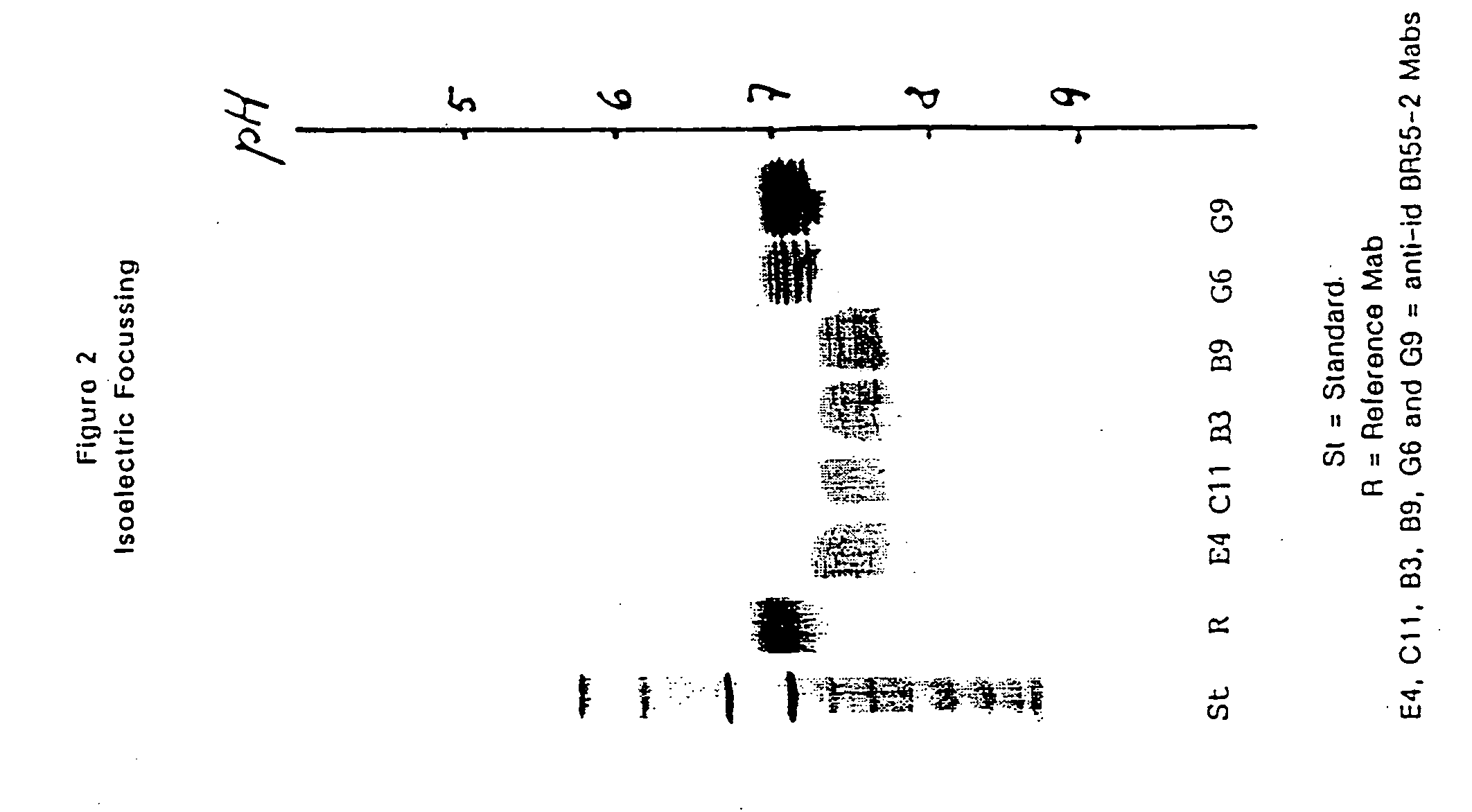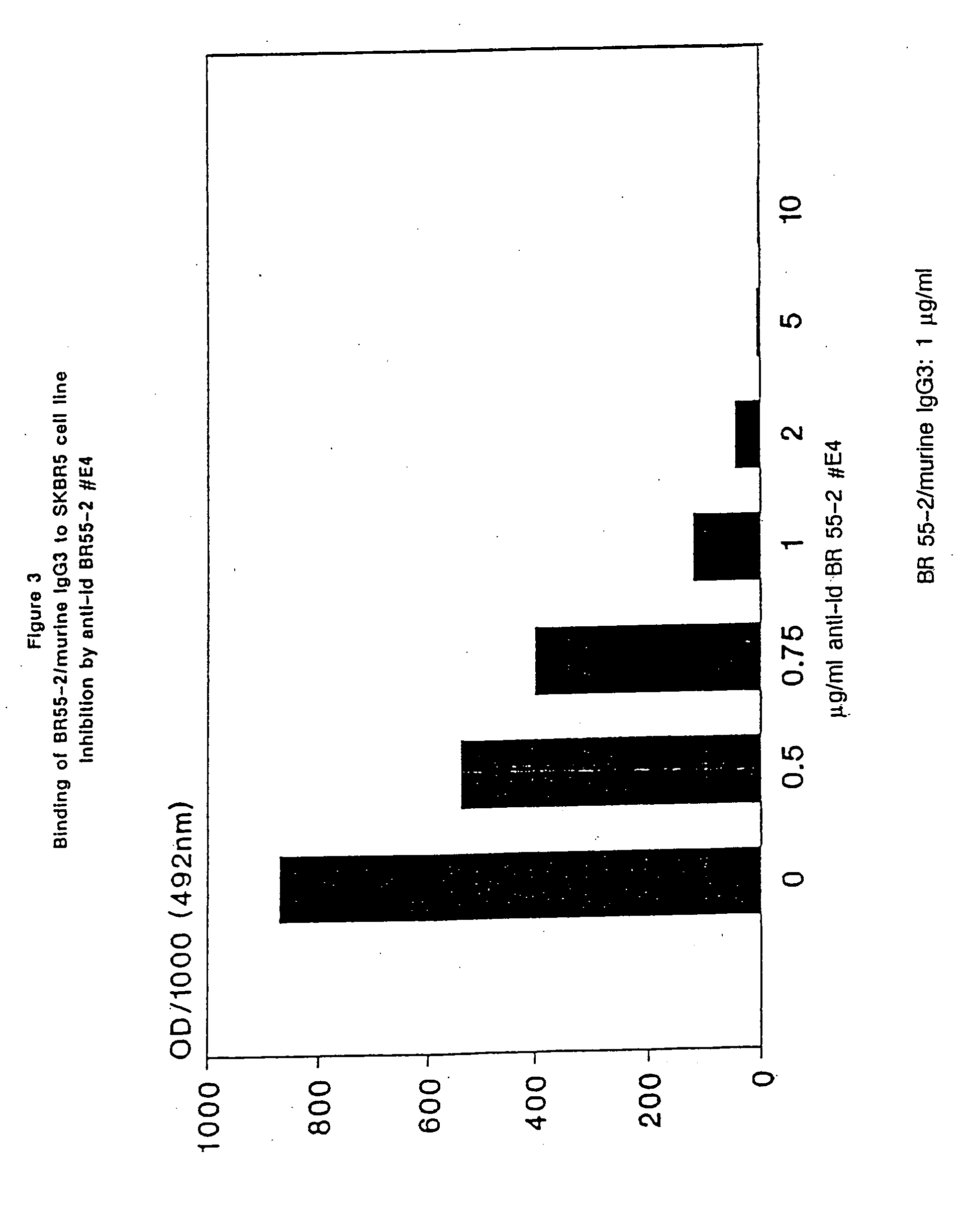Monoclonal antibodies and their use
a monoclonal antibody and antibody technology, applied in the field of monoclonal antibodies and their use, can solve the problems of evoking a very poor immune response in cancer patients, difficult to cure by eliminating both the virus and the proviral genetic information already transcribed into human genom from already infected patients, and the conventional chemotherapeutic approach is rather unsuccessful
- Summary
- Abstract
- Description
- Claims
- Application Information
AI Technical Summary
Problems solved by technology
Method used
Image
Examples
example 2
Quantitative Determination of Mouse IgG In Hybridoma Supernatants
[0162] 100 μl aliquots of rabbit-anti-mouse-IgG (such as the reagent of Nordic; 1:1000 in coating buffer) are added to the wells of microtiter plates, and incubated at 37° C. for 60 minutes. The plates are washed 6 times with washing buffer, 200 μl of PBS def. / 5% FCS are added and incubated for 30 minutes at 37° C. The plates are washed as described above. 100 μl aliquots of the hybridoma supernatants obtained after 2 weeks culture are added and the plates are incubated for 60 minutes at 37° C. Unbound antibody is washed out as described above and 100 μl aliquots of peroxidase-conjugated antibody (rabbit-anti-mouse-IgG / peroxidase such as the reagents of Dianova; 1:1000 in PBS / 2% FCS) are added. After incubation for 30 minutes at 37° C. the plates are washed 4 times with washing buffer and twice with staining buffer. 100 μl aliquots of substrate solution are added and color development is stopped after 5 minutes with 5...
example 3
Specific Binding of Hybridoma Supernatant-IgG to BR55-2 F(ab′)2-Fragment (ELISA)
[0163] Hybridomas producing sufficient mouse IgG (i.e. more as 10-fold optical density than the medium-blank) are subcloned to single cell culture in medium F and cultured in medium C for additional 2 weeks. The supernatants are tested as described in example 2, using 100 μl aliquots of F(ab′)2-fragment of BR55-2 (10 μg / ml; dilution in coating buffer).
example 4
Inhibition of Binding of BR55-2 / Murine IgG2a to SKBR5 Human Breast Cancer Cells by Hybridoma Supernatant-IgG (Cell ELISA)
[0164] All hybridoma supernatants which are positive in the above described assay are tested as follows:
[0165] Microtiter plates are pretreated with poly-L-lysine hydrobromide (20-30 kD; 20 μg / ml in PBS def.; 100 μl / well; 30 minutes, room temperature), washed twice with PBS def. (200 μl / well) and then incubated overnight at 4° C. with 50 μl / well of a suspension of SKBR5 cells in medium B (4×106 cells / ml). After removal of the supernatant the cells are fixed with 50 μl glutardialdehyde / well (0.1% in physiological saline) for 5 minutes at room temperature, the supernatants are removed, the cells resuspended in 200 μl / well of PBS def. / 1% BSA / 0.1% NaN3 and left for 1 hour at room temperature. Supernatants are removed and the plates are washed twice with 200 μl / well of PBS containing 0.05% Tween 20.
[0166] Hybridoma supernatants adjusted to 1 μg / ml mouse-IgG are prei...
PUM
| Property | Measurement | Unit |
|---|---|---|
| optical density | aaaaa | aaaaa |
| volume | aaaaa | aaaaa |
| flow rate | aaaaa | aaaaa |
Abstract
Description
Claims
Application Information
 Login to View More
Login to View More - R&D
- Intellectual Property
- Life Sciences
- Materials
- Tech Scout
- Unparalleled Data Quality
- Higher Quality Content
- 60% Fewer Hallucinations
Browse by: Latest US Patents, China's latest patents, Technical Efficacy Thesaurus, Application Domain, Technology Topic, Popular Technical Reports.
© 2025 PatSnap. All rights reserved.Legal|Privacy policy|Modern Slavery Act Transparency Statement|Sitemap|About US| Contact US: help@patsnap.com



